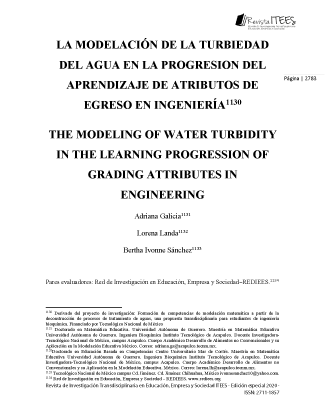CXLV. THE MODELING OF WATER TURBIDITY IN THE LEARNING PROGRESSION OF GRADING ATTRIBUTES IN ENGINEERING
##plugins.themes.bootstrap3.article.main##
Abstract
In the training of engineers, there is a disconnect between the practices of the professional
and school contexts, with an emphasis on learning basic sciences. This work presents results
of the staging of a didactic strategy (DE) that links the modeling practices of the biochemical
engineer (IBQ) in a water treatment plant and the modeling practices of IBQ students in the
class of diferential calculus. The work is in the theoretical framework of Socioepistemology
that considers the principles of the normative of social practice, that of contextualized
rationality, that of epistemological relativism and that of resignification (Cantoral, 2013).
The objective of the DE is for the student to model the quadratic from the turbidity
determination of water samples. Thus, developing the experimental, numerical, graphic, and
algebraic modeling. This work is qualitative and follows the methodological phases cited by
Galicia, Landa and Cabrera (2017) of what they call deconstruction of practices using the
model dipole as the unit of analysis (Arrieta and Díaz, 2014). Students manage to build the
numerical and graphic models in experimentation and the algebraic model with the help of
the Excel program. Contributing with this to the training the attributes of critical thinking and
problem-solving graduation from the subject of differential calculus and its transversal
relationship of the progressive reticular profile.
Download Statistics
##plugins.themes.bootstrap3.article.details##
modeling, science teaching, professional training
Revista Latinoamericana de Investigación en Matemática Educativa. 18 (1), 19-148.
Cantoral, R. (2013). Teoría socioepistemológica de la matemática Educativa. Estudios sobre
construcción social del conocimiento. España: Gedisa.
Cantoral; R., Montiel, G., Reyes, D. (2015). El programa socioepistemológico de
investigación en matemática Educativa: el caso de Latinoamérica en Revista
Latinoamericana de Investigación en Matemática Educativa (2015) 18 (1): 5-17. DOI:
10.12802/relime.13.1810
Cerrón, W. (2019). La investigación cualitativa en educación. Horizonte de la ciencia.
Universidad Nacional del Perú.17 (9).
Consejo de Acreditación de la Enseñanza de la Ingeniería A.C., CACEI (2017). Marco de
Referencia 2018 del CACEI en el contexto internacional. (ingenierías) Versión 2.
Revisión 0. Recuperado de: http://cacei.org.mx/nvfs/nvfs02/nvfs0210.php
Cordero, F., del Valle, T. y Morales, A. (2019). Usos de la optimización de ingenieros en
formación: el rol de la ingeniería mecatrónica y de la obra de Lagrange. Revista
Latinoamericana de Investigación en Matemática Educativa, 22 (2), 185-212.
Recuperada de https://doi.org/10.12802/relime.19.2223
Galicia, A. (2014). Desplazamiento de la práctica de diluciones entre la comunidad de
ingenieros bioquímicos y la escuela. Tesis de doctorado no publicada, Universidad
Autónoma de Guerrero. México
Galicia, A., Landa, L. y Cabrera, A.R. (2017). Reconstitución de prácticas sociales de
modelación: lo lineal a partir de análisis químicos El caso de la curva de calibración.
IE Revista de Investigación Educativa de la REDIECH. 15 (8), 29-55.
Grady, L. Jr., 2000, Notes prepared to accompany Unit Process in Environmental
Engineering: Boston, MA., PWS Publishing Co., Clemenson University, 2nd Edition,
26 p.Grady, L. Jr., 2000, Notes prepared to accompany Unit Process in Evironmental
Engineering, 2nd Edition, Clemenson University, PWS Publishing Co., Boston, MA.
Marín, R. (2014). Dinámica fisicoquímica de aguas. Madrid, Spain: Ediciones Díaz de
Santos. Recuperado de https://elibro.net/es/ereader/itacapulco/62908?page=13.
Moreno, J.A, Candela, A. y Buñuelos, P. (2019). Evaluaciones formativas en el aula: Análisis
discursivo de la actividad de retroalimentación en la práctica supervisada de
psicólogos educativos en formación. RIEE. Revista Iberoamericana de Evaluación
Educativa 12.1: 121-137. DOI: 10.15366/riee2019.12.1.007
Posada, G. J. (2012). Ecuaciones: lineal y cuadrática. Universidad Católica Luis Amigó.
Recuperado de https://elibro.net/es/ereader/itacapulco/127438?page=22.
Secretaria de Economía (2001). NMX-AA-038-SCFI-2001. Análisis de agua determinación
de turbiedad en aguas naturales, residuales y residuales tratadas. Método de prueba
Talanquer, V. (2013). Progresiones de aprendizaje: promesa y potencial. Educación química,
24(4), 362-364. Recuperado de
http://www.scielo.org.mx/scielo.php?script=sci_arttext&pid=S0187-
893X2013000400001&lng=es&tlng=es.
TecNM. Tecnológico Nacional de México (2012). Modelo Educativo para el Siglo XXI
Formación y Desarrollo de competencias profesionales. Recuperado de
https://www.tecnm.mx/director-general/modelo-educativo-para-el-siglo-xxiformacion-y-desarrollo-de-competencias-profesionales.
TecNM. Tecnológico Nacional de México, Instituto Tecnológico de Acapulco (2018). Plan
de estudios de Ingeniería Bioquímica. Retícula: IBQA -2010-207 (Competencias
profesionales). Recuperado de: http://it-acapulco.edu.mx/ingenieria-bioquimica/





